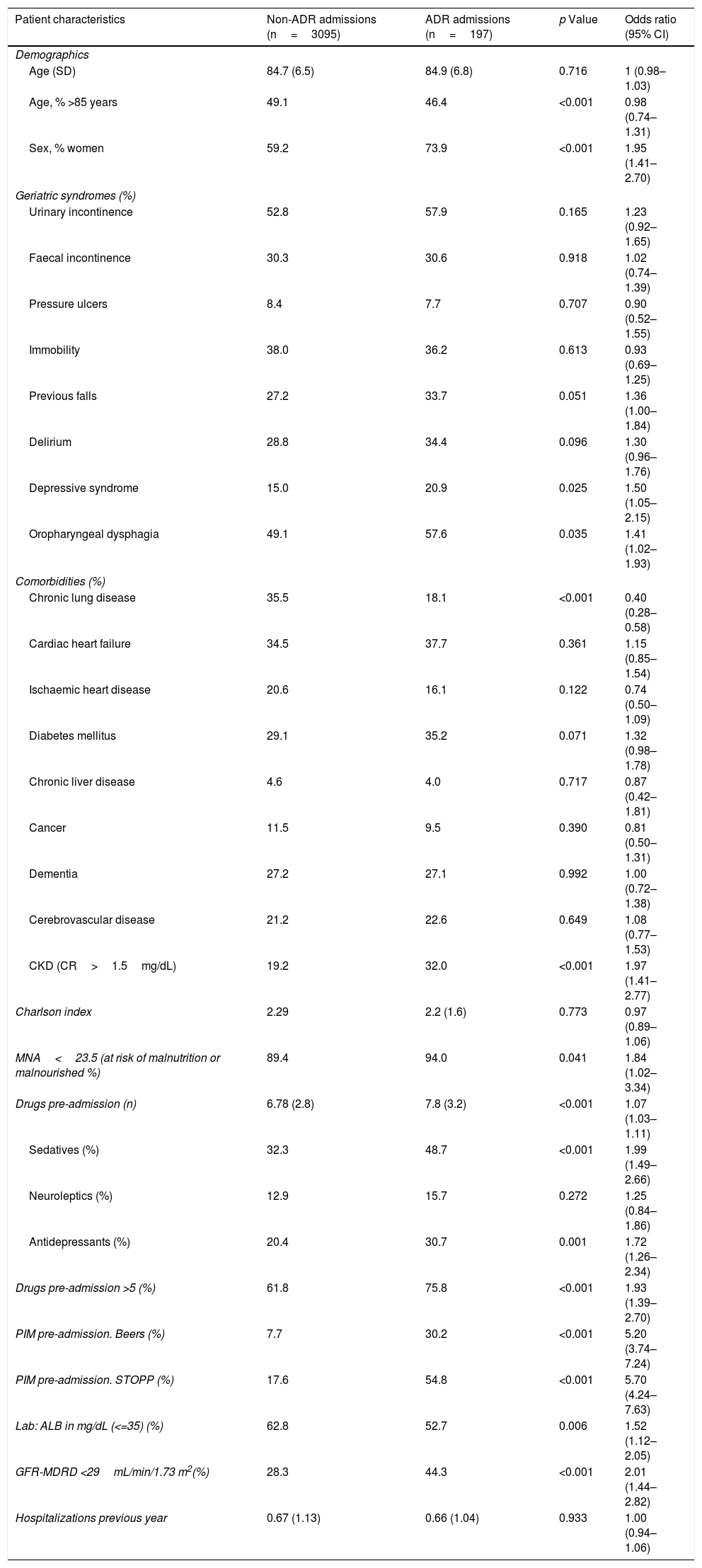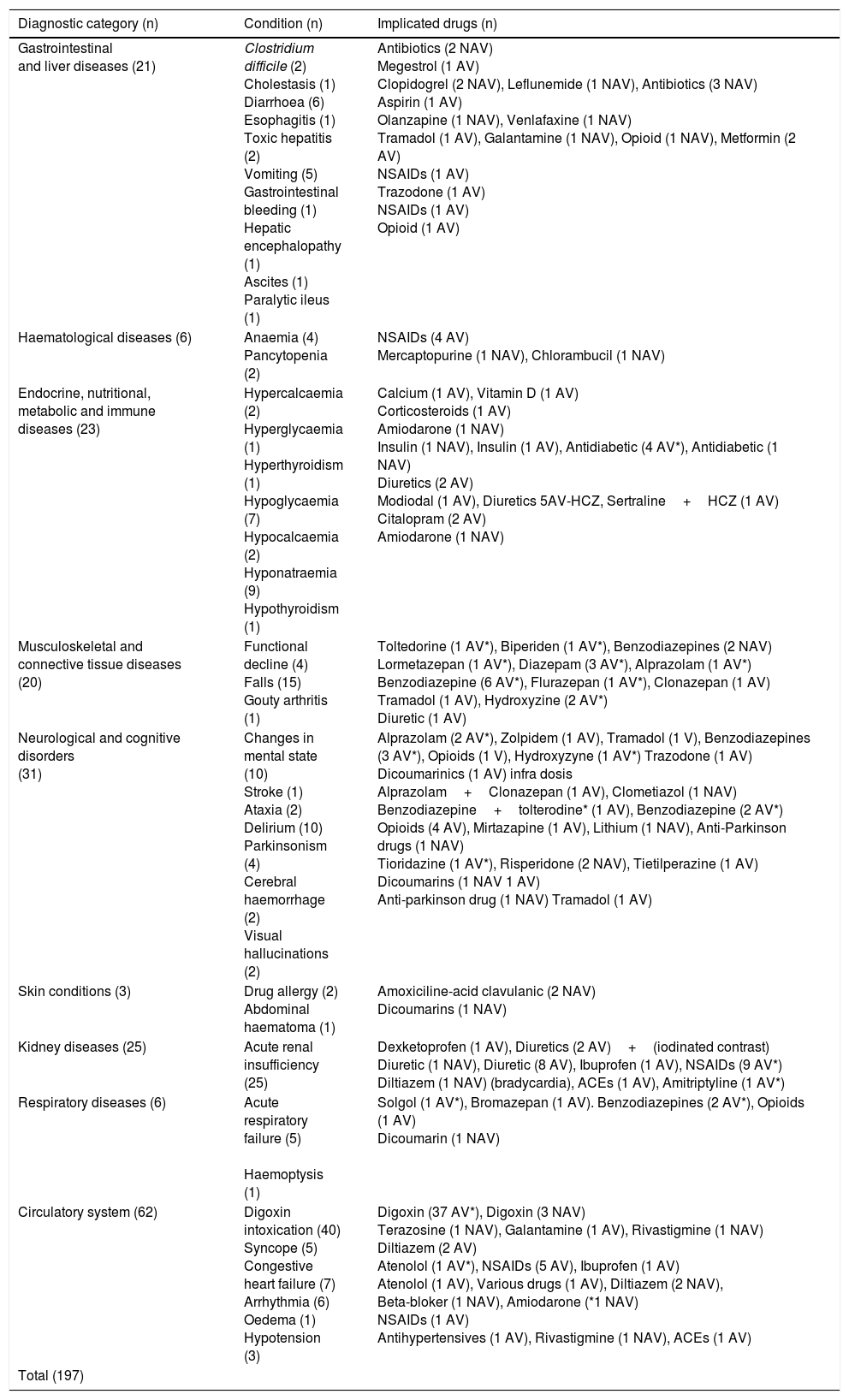To determine prevalence of admissions due to an adverse drug reaction (ADR) and determine whether or not admission was avoidable, and what drugs and risk factors were implicated.
DesignCross-sectional observational study.
Study sampleAll patients hospitalized in an acute geriatric unit during the period January 2001 to December 2010 were studied.
MeasurementTo determine whether admissions were due to ADR, we used the World Health Organization-Uppsala Monitoring Centre criteria and the Naranjo scale. Beers criteria were used to detect potentially inappropriate medication.
ResultsA total of 3292 patients (mean age 84.7 years, 60.1% women) were studied. Of these, 197 (6%) were admissions for ADR and nearly three quarters (76.4%, 152 cases) were considered avoidable admissions. The five most frequent drugs associated with admissions for ADR were digoxin, nonsteroidal anti-inflammatory drugs, benzodiazepines, diuretics and antibiotics. Independent risk factors for admissions for ADR were being female (OR 1.84; 95% CI: 1.30–2.61), inappropriate medication according to Beers criteria (OR 4.20; 95% CI: 2.90–6.03), polypharmacy (>5 drugs) (OR 1.50; 95% CI: 1.04–2.13), glomerular filtration rate<30mL/min (OR 3; 95% CI: 2.12–4.23) and sedative use (OR 1.40; 95% CI: 1–1.91).
ConclusionADR were responsible for 6% of admissions to an acute geriatric unit, and over 75% of these admissions were considered avoidable. Associated risk factors were being female, inappropriate medication, polypharmacy, renal insufficiency and sedative use.
Determinar la prevalencia de ingresos por reacciones adversas a medicamentos (RAM) y si el ingreso era evitable o no, y qué fármacos y factores de riesgo estaban implicados.
DiseñoEstudio observacional transversal.
Muestra de estudioTodos los pacientes hospitalizados en una unidad geriátrica de agudos durante el período de enero de 2001 a diciembre de 2010 fueron estudiados.
MedicionesPara determinar si los ingresos se debieron a RAM se utilizaron los criterios de la World Health Organization-Uppsala Monitoring Centre y la escala de Naranjo. Para detectar los medicamentos potencialmente inadecuados se utilizaron los criterios de Beers.
ResultadosSe estudió un total de 3.292 pacientes (edad media 84,7 años, 60,1% mujeres). De estos, 197 (6%) fueron ingresos por RAM, de los cuales 152 (76,4%) se consideraron ingresos evitables. Los 5 grupos de fármacos más frecuentemente asociados a los ingresos por RAM fueron digoxina, antiinflamatorios no esteroideos, benzodiacepinas, diuréticos y antibióticos. Los factores de riesgo independientes de ingreso por RAM fueron el sexo femenino (OR 1,84; IC 95% 1,3–2,61), la medicación inadecuada según los criterios de Beers (OR 4,2; IC 95% 2,9-6,03), la polifarmacia (>5 fármacos) (OR 1,5; IC 95% 1,04-2,13), el filtrado glomerular<30ml/min (OR 3; IC 95% 2,12-4,23) y el uso de sedantes (OR 1,4; IC 95% 1-1,91).
ConclusiónLas RAM fueron responsables del 6% de los ingresos en una unidad geriátrica de agudos, considerándose evitables tres cuartas partes de estos ingresos. El sexo femenino, la medicación inadecuada, la polifarmacia, la insuficiencia renal y el uso de sedantes fueron factores de riesgo independientes de ingreso por RAM.









